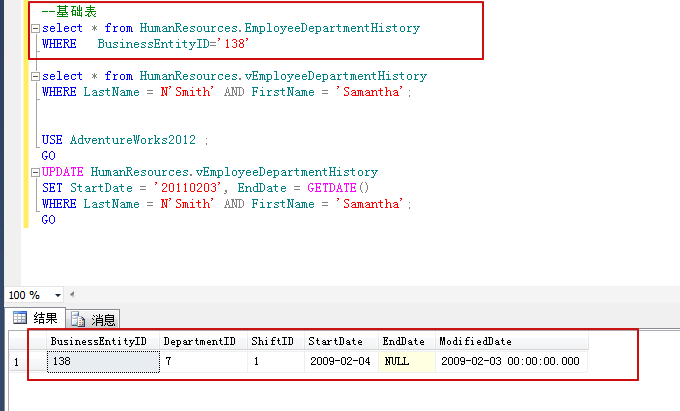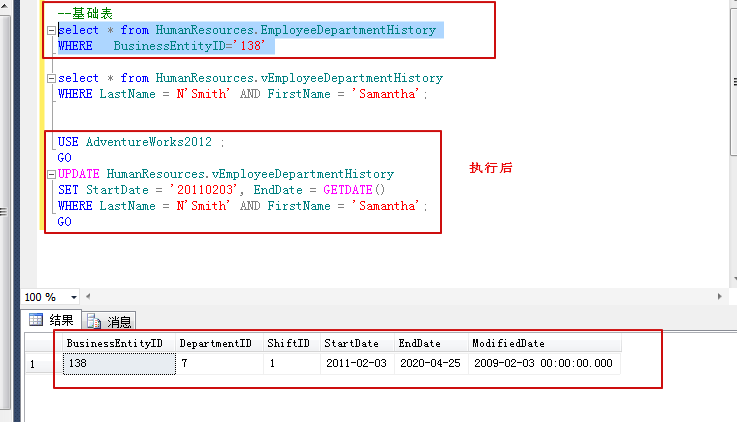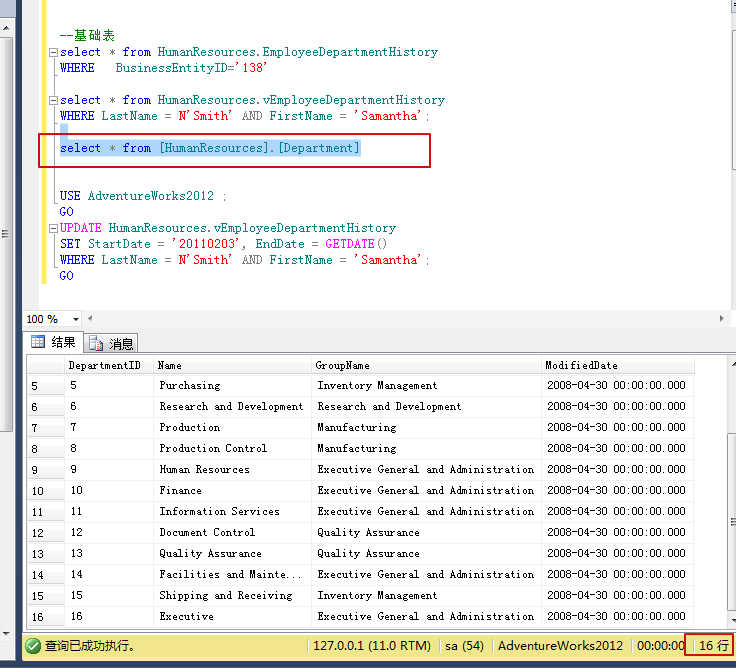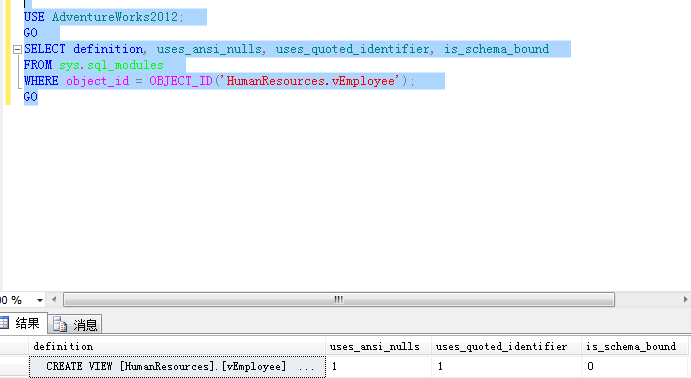视图
视图是一个虚拟表,其内容由查询定义。
视图的作用
- 对于视图所引用的基础表来说,视图的作用类似于筛选。定义视图的筛选可以来自:当前或者其他数据库的一个或多个表或者视图。
- 视图通常用来集中、简化和自定义每个用户对数据库的不同认识。视图可用作安全机制,方法是允许用户通过视图访问数据,而不授予用户直接访问视图基础表的权限。视图可用于提供向后兼容接口来模拟曾经存在但其架构已更改的表。还可以在向SQL sever 复制数据和从其中复制数据时使用视图,以便提高性能并对数据进行分区。
视图的类型
- 索引视图:索引视图是被具体化了的视图。可以为视图创建索引,即对视图创建一个唯一索引。索引视图可以显著提高某些类型查询的性能。索引视图尤其适于聚合许多行的查询,但它们不适于经常更新的基本数据集。
- 分区视图:分区视图在一台或多台服务器间水平连接一组成员表中的分区数据。这样,数据看上去如同来自同一个表。
- 系统视图:系统视图公开目录元数据。可以使用系统视图返回与SQL server实例或在该实例中定义的对象有关的信息。例如,查询sys.databases 目录视图以便返回与实例中提供的用户定义数据库有关的信息。
1.创建视图
USE AdventureWorks2012 ; GO CREATE VIEW HumanResources.EmployeeHireDate AS SELECT p.FirstName, p.LastName, e.HireDate FROM HumanResources.Employee AS e JOIN Person.Person AS p ON e.BusinessEntityID = p.BusinessEntityID ; GO -- Query the view SELECT FirstName, LastName, HireDate FROM HumanResources.EmployeeHireDate ORDER BY LastName;
2.创建索引视图
对视图创建的第一个索引必须是唯一聚集索引。创建唯一聚集索引后,可以创建更多非聚集索引。
为视图创建唯一聚集索引可以提高查询性能,因为视图在数据库中的存储方式与具有聚集索引的表的存储方式相同。
以下示例将创建一个视图并为该视图创建索引。 包含两个查询,它们使用 AdventureWorks 数据库中的索引视图。
--Set the options to support indexed views.设置这些选项来支持索引视图 SET NUMERIC_ROUNDABORT OFF; SET ANSI_PADDING, ANSI_WARNINGS, CONCAT_NULL_YIELDS_NULL, ARITHABORT, QUOTED_IDENTIFIER, ANSI_NULLS ON; --Create view with schemabinding. IF OBJECT_ID ('Sales.vOrders', 'view') IS NOT NULL DROP VIEW Sales.vOrders ; GO CREATE VIEW Sales.vOrders WITH SCHEMABINDING AS SELECT SUM(UnitPrice*OrderQty*(1.00-UnitPriceDiscount)) AS Revenue, OrderDate, ProductID, COUNT_BIG(*) AS COUNT FROM Sales.SalesOrderDetail AS od, Sales.SalesOrderHeader AS o WHERE od.SalesOrderID = o.SalesOrderID GROUP BY OrderDate, ProductID; GO --Create an index on the view.在视图上创建索引 CREATE UNIQUE CLUSTERED INDEX IDX_V1 ON Sales.vOrders (OrderDate, ProductID); GO --This query can use the indexed view even though the view is --not specified in the FROM clause. SELECT SUM(UnitPrice*OrderQty*(1.00-UnitPriceDiscount)) AS Rev, OrderDate, ProductID FROM Sales.SalesOrderDetail AS od JOIN Sales.SalesOrderHeader AS o ON od.SalesOrderID=o.SalesOrderID AND ProductID BETWEEN 700 and 800 AND OrderDate >= CONVERT(datetime,'05/01/2002',101) GROUP BY OrderDate, ProductID ORDER BY Rev DESC; GO --This query can use the above indexed view. SELECT OrderDate, SUM(UnitPrice*OrderQty*(1.00-UnitPriceDiscount)) AS Rev FROM Sales.SalesOrderDetail AS od JOIN Sales.SalesOrderHeader AS o ON od.SalesOrderID=o.SalesOrderID AND DATEPART(mm,OrderDate)= 3 AND DATEPART(yy,OrderDate) = 2002 GROUP BY OrderDate ORDER BY OrderDate ASC;
3.修改视图
修改视图时,无需删除并重新创建视图。
USE AdventureWorks2012 ; GO -- Create a view. 创建视图 CREATE VIEW HumanResources.EmployeeHireDate AS SELECT p.FirstName, p.LastName, e.HireDate FROM HumanResources.Employee AS e JOIN Person.Person AS p ON e.BusinessEntityID = p.BusinessEntityID ; -- Modify the view by adding a WHERE clause to limit the rows returned. 修改视图 ALTER VIEW HumanResources.EmployeeHireDate AS SELECT p.FirstName, p.LastName, e.HireDate FROM HumanResources.Employee AS e JOIN Person.Person AS p ON e.BusinessEntityID = p.BusinessEntityID WHERE HireDate < CONVERT(DATETIME,'20020101',101) ; GO
4.通过视图修改数据
这里先给出视图定义
CREATE VIEW [HumanResources].[vEmployeeDepartmentHistory] AS SELECT e.[BusinessEntityID] ,p.[Title] ,p.[FirstName] ,p.[MiddleName] ,p.[LastName] ,p.[Suffix] ,s.[Name] AS [Shift] ,d.[Name] AS [Department] ,d.[GroupName] ,edh.[StartDate] ,edh.[EndDate] FROM [HumanResources].[Employee] e INNER JOIN [Person].[Person] p ON p.[BusinessEntityID] = e.[BusinessEntityID] INNER JOIN [HumanResources].[EmployeeDepartmentHistory] edh ON e.[BusinessEntityID] = edh.[BusinessEntityID] INNER JOIN [HumanResources].[Department] d ON edh.[DepartmentID] = d.[DepartmentID] INNER JOIN [HumanResources].[Shift] s ON s.[ShiftID] = edh.[ShiftID];
a. 通过视图更新数据
USE AdventureWorks2012 ; GO UPDATE HumanResources.vEmployeeDepartmentHistory SET StartDate = '20110203', EndDate = GETDATE() WHERE LastName = N'Smith' AND FirstName = 'Samantha'; GO
执行前的状态

执行后的状态

此视图从两个表返回值。 此语句会成功,因为修改的列都来自一个基表。
b. 通过视图插入表数据
USE AdventureWorks2012 ; GO INSERT INTO HumanResources.vEmployeeDepartmentHistory (Department, GroupName) VALUES ('MyDepartment', 'MyGroup'); GO
执行前

执行后

5.获取信息(视图的定义和属性)
a.获取视图的定义和属性
USE AdventureWorks2012; GO SELECT definition, uses_ansi_nulls, uses_quoted_identifier, is_schema_bound FROM sys.sql_modules WHERE object_id = OBJECT_ID('HumanResources.vEmployee'); GO
USE AdventureWorks2012; GO SELECT OBJECT_DEFINITION (OBJECT_ID('HumanResources.vEmployee')) AS ObjectDefinition; GO
EXEC sp_helptext 'HumanResources.vEmployee';

b.获取视图的依赖关系
USE AdventureWorks2012; GO SELECT OBJECT_NAME(referencing_id) AS referencing_entity_name, o.type_desc AS referencing_desciption, COALESCE(COL_NAME(referencing_id, referencing_minor_id), '(n/a)') AS referencing_minor_id, referencing_class_desc, referenced_class_desc, referenced_server_name, referenced_database_name, referenced_schema_name, referenced_entity_name, COALESCE(COL_NAME(referenced_id, referenced_minor_id), '(n/a)') AS referenced_column_name, is_caller_dependent, is_ambiguous FROM sys.sql_expression_dependencies AS sed INNER JOIN sys.objects AS o ON sed.referencing_id = o.object_id WHERE referencing_id = OBJECT_ID(N'Production.vProductAndDescription'); GO
6.重命名视图
可以使用sp_rename,但是建议删除现有视图,然后使用新名称重新创建。
7.删除视图
USE AdventureWorks2012 ; GO IF OBJECT_ID ('HumanResources.EmployeeHireDate', 'V') IS NOT NULL DROP VIEW HumanResources.EmployeeHireDate; GO






【推荐】国内首个AI IDE,深度理解中文开发场景,立即下载体验Trae
【推荐】编程新体验,更懂你的AI,立即体验豆包MarsCode编程助手
【推荐】抖音旗下AI助手豆包,你的智能百科全书,全免费不限次数
【推荐】轻量又高性能的 SSH 工具 IShell:AI 加持,快人一步
· AI与.NET技术实操系列:基于图像分类模型对图像进行分类
· go语言实现终端里的倒计时
· 如何编写易于单元测试的代码
· 10年+ .NET Coder 心语,封装的思维:从隐藏、稳定开始理解其本质意义
· .NET Core 中如何实现缓存的预热?
· 分享一个免费、快速、无限量使用的满血 DeepSeek R1 模型,支持深度思考和联网搜索!
· 基于 Docker 搭建 FRP 内网穿透开源项目(很简单哒)
· 25岁的心里话
· ollama系列01:轻松3步本地部署deepseek,普通电脑可用
· 按钮权限的设计及实现
2019-04-25 asp.net core 系列之中间件进阶篇-编写自定义中间件(middleware)
2019-04-25 asp.net core 系列之并发冲突